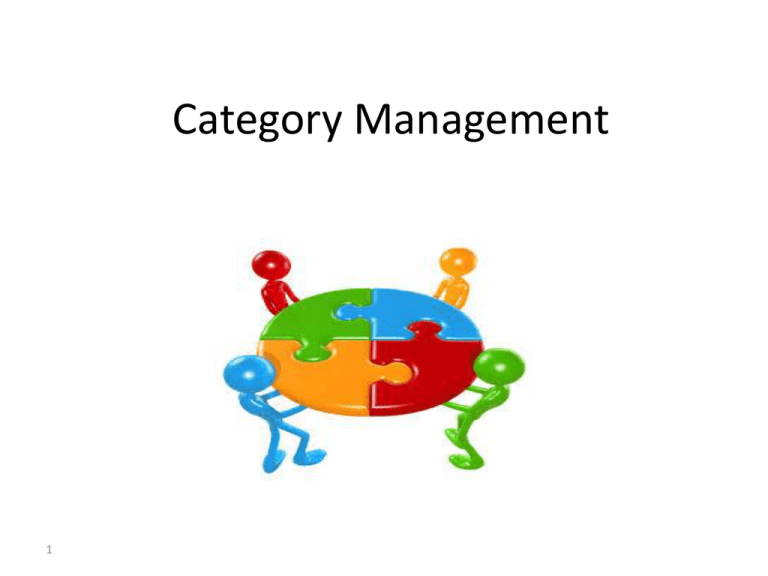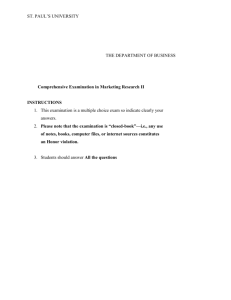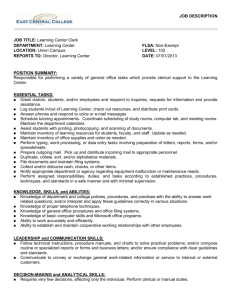Presentazione standard di PowerPoint
advertisement

Category Management 1 Category Management What is Category Management? • "organising the resources of the procurement team in such a way as to focus externally onto the supply markets of an organisation in order to fully leverage purchasing decisions”. - Definition from Chartered Institute of Purchasing & Supply • A ‘category’ is the logical grouping of similar expenditure: paint, parts and labour, which in turn influence the Repair of vehicles, i.e. the repair category. Category management is the supply chain process used to manage these categories to satisfy business needs and strategy while maximising the value delivered from the supplier base. 8 Step Cycle 1. 2. 3. 4. 5. 6. 7. 8. Define the category (i.e. what products are included/excluded). Define the role of the category within the business. Assess the current performance. Set objectives and targets for the category. Devise an overall Strategy. Devise specific tactics. Implementation. The eighth step is one of review which takes us back to step 1. Sample Below you will find a sample of a category plan which is aimed at the Insurance Motor vehicle repair market, more specifically on parts. . This should give you a high level example and view of how this works 2 Motor Repair – Parts Motor Category Plan Presentation 2013/4 Overall Strategy Indemnity Expense Customer Flexibility 2 Control indemnity Leveraging controllable volume by consolidating spend where possible Drive improved repair methodology Manage internal costs in line with total cost ownership Create flexible model to deal with peaks and troughs of work during the year Balance outsourcing with in-house spend to achieve optimum spend Move up the NPS score Constantly asses and audit customer services structures to asses gap analysis Target service at the right cost. Allow flexibility to cater with changes is the marker Flexible suppliers and model to adapt with changes in the lines of business How should we approach Motor Parts sourcing? BOTTLENECK Market Complexity & Risk • Widen specification / Substitutes •Increase competition •Develop new suppliers •Medium-term contracts •Technical relationships •Decrease uniqueness of suppliers •Manage closely Ensure supply continuity ROUTINE STRATEGIC • Encourage innovation •Supplier Relationship Management •Prepare contingency plans •Analyse market / competitors •Use functional specifications •Increase role of selected suppliers Develop collaborative relations LEVERAGE • Increase role of systems •Reduce buying effort •Rationalise supply base •Automate requisitioning (e.g. EDI etc) •Stockless procurement •Minimise admin costs Automate and Simplify • Concentrate business •Maintain competition •Promote competitive bidding •Exploit market cycles/trends •Procurement co-ordination •Industry standards Maximise commercial advantage Value or Profit Impact 5 Parts Market – PESTLE Analysis POLITICAL Legislation challenging constantly the insurance market. Need to ensure all structures are put in place to cater for this. TECHNOLOGY Various systems like Audatex provide both a strong assessment method and ability to show how best to use alternative parts. 6 Confidential ECONOMIC SOCIAL General Economic downturn means alternative economical parts such as green parts are growing in demand and availability. Challenges on belief that non original parts are of lesser quality is still apparent though less when cost have to be absorbed directly by the customers. LEGISLATION Legislation like BLOC exemption stopping Manufacturers from creating an oligopoly in the market and provision of parts . ENVIRONMENTAL Category management may show how the market is changing and the increased technology makes it easier to acquire used-recycled parts of traceable quality. SWOT Analysis STRENGTHS •Range of suppliers can provide broad range of solutions for parts consumption. • Availability of a mature distribution network means parts are being supplied locally very quickly. • Legislative effects increase the ability for large buyers such as Insurers to contain Manufacturer costs. OPPORTUNITIES •Cut down on layers and contract directly with Manufacturers to agree inflation busting and agreed price list buying of parts. •Removes burden for repairers to have to pay for parts themselves (cashflow), and can influence the spend on the labour portion. •Generate indemnity & income benefit by substitution alternative and green parts. 7 WEAKNESSES •Numerous suppliers and levels of supply also mean that a margin is made at every level. • Logistics and distribution is weakened as soon as volumes are consolidated into a smaller number of suppliers, which impacts CPD. THREATS /RISKS •Growth in vehicle telematics. Manufactuers notified when vehicle involved in collision, broken down etc. •E-call 2015. Losing FNOL control to Manufacturers. Parts Category: a view of the market.. The Parts market • Parts have been experiencing a downturn in growth, influenced by the auto sales and the market conditions since 2008; forecasted to hit 12.3billion turnover in 2013 which is negative growth of - 2.7% over the five years. • An ageing car park = older parts to be held for longer, and OEM’s to produce older stock for longer. • Parts currently purchased by body shops through: OEM’s, and wholesaler, which include alternative, OES and green parts. • Alternative cheaper options, more efficient repair over replace = OEM’s or Manufacturers losing share, though cost of parts is kept lower. • Car sales trends show that there is a greater sale of supermini’s and lower medium cars, which will influence the spare parts replacement Ford Fiesta have been sold the most! 8 Parts Market and Insurance Parts usage in a repair is controlled by the workflow management systems, to ensure the Insurance companies have a clearer view of the usage. Systems can suggest both substitute parts, and green parts for the replacement of a part, in line with the work providers rule set. Parts are charged by body shops as a discount on manufacturers retail price.(except for NRCM – at cost) Manufacturers are aware of the trends and the growth of repair over replace and alternative parts, so have realised that where an insurer does not specify use of original parts in the policies and supply chain, they lose the share, therefore keen on having direct relationships with Insurers and in some cases have been able to establish this. Parts Category and Company Spend Parts going forwards • Market fragmentation, substitutes, means Manufacturers losing revenue and looking to solve this. • Manufacturers are implementing through partners direct distribution channels in the UK to allow direct purchase. • Major Purchasers like Insurers have a window of opportunity to agree with manufacturers. • Recycled parts and substitute parts are being pushed into the network at very competitive rates. 9 Company Parts going forwards • Opportunities can be through OES and direct buying. • Due to the complexity of looking into direct parts procurement and distribution, Company has used it’s efforts more on improving other areas of repair rather than parts. • Company should use the supply chain currently in place to drive more innovation on buying parts in the market. By leveraging the consolidated buying power. VAUXHALL (NEW) ZAFIRA FORD FIESTA 14% 28% FORD FOCUS 18% VAUXHALL (NEW) ASTRA 18% NISSAN QASHQAI 22% KIA TOYOTA VOLVO HONDA AUDI MERCEDES-BENZ CITROEN BMW RENAULT PEUGEOT VOLKSWAGEN NISSAN VAUXHALL (NEW) £16,000,000.00 £14,000,000.00 £12,000,000.00 £10,000,000.00 £8,000,000.00 £6,000,000.00 £4,000,000.00 £2,000,000.00 £- FORD Company Part Category • In 2012 Company spent X m on parts, of which 87% of the spend was with 14 manufacturer brands. • The cost in the managed network for parts was of Xm, with an average cost per repair of £X with 35% (18m) of this spend through Repairer A. • Company does not buy parts directly from manufacturers or distributors, but through garages • Distribution on the network is the responsibility of each repairer, and each one buys from different distributors. • The use of alternative parts is not as common in the Company supply chain as it could be, although this is due to Company not requesting this.. Company Parts Strategy Time taken to develop Flexibility Indemnity Customer Indemnity Year 3 Have all solutions in place to cater for changes in customers needs, business lines, and legislations Year 3 Implement alternative parts and recycled parts procurement through a tender for this. Year 2 Use greater control to push for better service through buying power for sourcing of parts Year 1 Further consolidated supply chain by mandating parts bought from direct distribution networks Greater control of spend 2 Activity Map: Year 1 – Year 3 Year 3 (2015/6) Year 2 (2014/5) Year 1 (2013/4) 11 Develop strong relationships with both alternative market and VM ensuring all repair contracts are contracted to use mandated parts solutions Tender alternative and green parts Pilot alternative and green parts Develop Manufacturer relationships and commence pilots for direct procurement of parts and development on distribution network. Tender all parts provider contracts Motor Repair – Parts Thank you



